

Autism and working memory. Autism is a disorder of neural development characterized by impaired social interaction and communication, and by restricted and repetitive behavior.
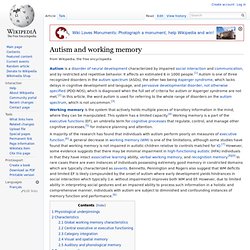
It affects an estimated 6 in 1000 people.[1] Autism is one of three recognized disorders in the autism spectrum (ASDs), the other two being Asperger syndrome, which lacks delays in cognitive development and language, and pervasive developmental disorder, not otherwise specified (PDD-NOS), which is diagnosed when the full set of criteria for autism or Asperger syndrome are not met.[2] In this article, the word autism is used for referring to the whole range of disorders on the autism spectrum, which is not uncommon.[3] Working memory is the system that actively holds multiple pieces of transitory information in the mind, where they can be manipulated.
Physiological underpinnings[edit] The physical underpinnings of the cause for differences in the working memory of autistic people has been studied. Interpersonal relationship. Field of study[edit] The study of interpersonal relationships involves several branches of the social sciences, including such disciplines as sociology, psychology, anthropology, and social work.

Interpersonal skills are extremely vital when trying to develop a relationship with another person. The scientific study of relationships evolved during the 1990s and came to be referred to as 'relationship science',[1] which distinguishes itself from anecdotal evidence or pseudo-experts by basing conclusions on data and objective analysis. Autism and working memory. Autism Evolution Simulator. Temple Grandin discusses Autism Spectrum Disorder on TED.com. Dr. Temple Grandin Describes Thinking in Pictures. The Brain of an Autistic child + Temple Grandin. Memory and social interactions. Memory underpins and enables social interactions in a variety of ways.
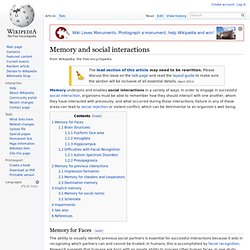
In order to engage in successful social interaction, organisms must be able to remember how they should interact with one another, whom they have interacted with previously, and what occurred during those interactions. Failure in any of these areas can lead to social rejection or violent conflict, which can be detrimental to an organism's well being. Memory for Faces[edit] Brain Structures[edit] There are several areas of the brain associated with this highly specialized form of memory. Fusiform face area[edit] The fusiform face area (FFA) is associated with facial recognition. Damage to the FFA has been shown to lead to severe deficits in facial recognition and processing.[5] These deficits can lead to difficulty in maintaining normal social relationships over an extended period. Asperger syndrome and neuroscience. Asperger syndrome (AS) is a neurodevelopmental condition.
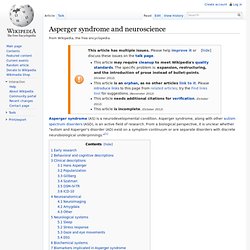
Asperger syndrome, along with other autism spectrum disorders (ASD), is an active field of research. From a biological perspective, it is unclear whether "autism and Asperger's disorder (AD) exist on a symptom continuum or are separate disorders with discrete neurobiological underpinnings. Intressant artikelserie om asperger och hur det fungerar : Att leva som Aspergare.
Några godbitar angående hyperfokus, distraktion och nervkopplingar: Part 22 - Information Processing and Autistic Spectrum Individuals A recent study in the UK suggests what Autistic Spectrum individuals have been saying amongst themselves for years - we are capable of processing VAST amounts of information...
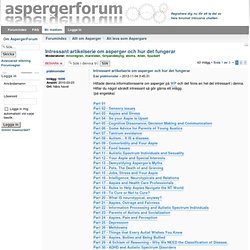
Often much more than Neurotypicals. The study presented information rapidly, and Autistic Spectrum individuals were able to process the information much more rapidly than NTs. It also states that Autistic Spectrum individuals were better at detecting "critical" information. The scientists conducted their study on 32 adults. This constant filtering is both a great strength in NT perceptual cognition and a flaw, as things can easily be overlooked. Part 37 - The Autistic Brain vs. Karen Weintraub. Structure of language pathways differs in non-verbal autism — Size matters: Based on diffusion tensor imaging, two language-related areas of the brain are much smaller in non-verbal children with autism than in controls.
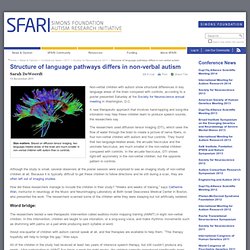
Non-verbal children with autism show structural differences in key language areas of the brain compared with controls, according to a poster presented Saturday at the Society for Neuroscience annual meeting in Washington, D.C. A new therapeutic approach that involves hand-tapping and song-like intonation may help these children learn to produce speech sounds, the researchers say. The researchers used diffusion tensor imaging (DTI), which uses the flow of water through the brain to create a picture of nerve fibers, in four non-verbal children with autism and four controls. They found that two language-related areas, the arcuate fasciculus and the uncinate fasciculus, are much smaller in the non-verbal children compared with controls. How did these researchers manage to include the children in their study? Word bridge: References:
Autism spectrum. The autism spectrum or autistic spectrum describes a range of conditions classified as neurodevelopmental disorders in the fifth revision of the American Psychiatric Association's Diagnostic and Statistical Manual of Mental Disorders 5th edition (DSM-5).

The DSM-5, published in 2013, redefined the autism spectrum to encompass the previous (DSM-IV-TR) diagnoses of autism, Asperger syndrome, pervasive developmental disorder not otherwise specified (PDD-NOS), and childhood disintegrative disorder.[1] These disorders are characterized by social deficits and communication difficulties, stereotyped or repetitive behaviors and interests, sensory issues, and in some cases, cognitive delays.
The Autistic Brain" Much like a computer, the brain relies on intricate wiring to process and transmit information.
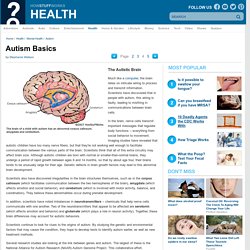
Scientists have discovered that in people with autism, this wiring is faulty, leading to misfiring in communications between brain cells. In the brain, nerve cells transmit important messages that regulate body functions -- everything from social behavior to movement. Imaging studies have revealed that autistic children have too many nerve fibers, but that they're not working well enough to facilitate communication between the various parts of the brain. Scientists think that all of this extra circuitry may affect brain size. Although autistic children are born with normal or smaller-than-normal brains, they undergo a period of rapid growth between ages 6 and 14 months, so that by about age four, their brains tends to be unusually large for their age. In addition, scientists have noted imbalances in neurotransmitters -- chemicals that help nerve cells communicate with one another. Families and Adults/Resource Library. Autism art.
ABPathfinder.